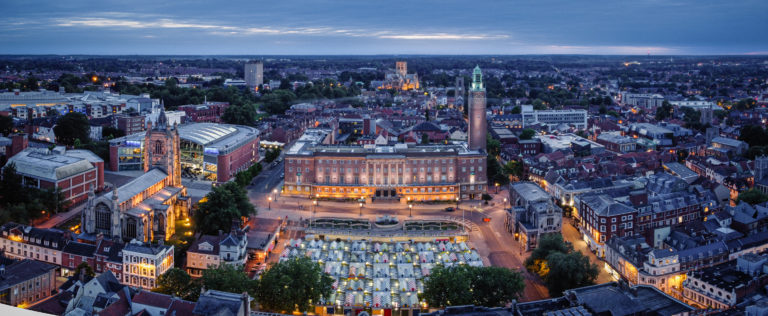PLMR East of England has pulled together a summary of the key election outcomes across the region. Generally, local elections followed the national trend of consolidating Conservative power. A few particularly interesting outcomes – namely the Conservatives gaining control of Harlow, Welwyn Hatfield and Basildon Councils – sought to reiterate this trend, however; a few anomalies did throw this out of balance. Not many people could have called Labour candidate Nik Johnson winning the Cambridgeshire and Peterborough Combined Authority Mayoralty from Conservative incumbent James Palmer, nor could they have called the Lib Dems taking control of the Cambridgeshire County Council from the Conservatives. Many factors were at play at this unique set of Local Elections, with national events like COVID-19 playing a significant role in the voting outcomes.
EAST OF ENGLAND COUNTY COUNCILS
Cambridgeshire County Council – Despite the huge Conservative wins across the rest of the Country, Cambridgeshire County Council Conservatives have failed to hold on to their majority following big gains made by the Liberal Democrats. The County Council leading party has faced criticism recently following the ongoing Hickford Farm scandal (what has come to be known as ‘farmgate’), which could have played a big part in the Conservatives demise this year. Having only just won the majority back in 2017 following 4 years of NOC, the Conservatives had hoped to hold onto their majority, but Lib Dems had other ideas, managing to win a whopping 20 seats. Compared to the 14 seats won in 2017, Cambridgeshire Lib Dems will be very pleased with this result. Indeed, the increase in Lib Dem wins at the County Council may reflect a wider shift toward Lib Dem ideology in the region, with South Cambs District Council electing a large Lib Dem majority in 2018 and the 2019 Lib Dem General Election candidate, Ian Sollom, missing out on becoming MP by a mere 4.3%.
Essex County Council – The Conservatives were never expected to lose the County Council, and indeed managed to marginally tighten their majority – which they have held since 1995. The Conservatives lost 4 seats but made 1 gain, resulting in 52 seats out of 75 overall. Conservative Cllr Kevin Bentley, who had been acting leader of the Council after the decision by previous leader David Finch not to stand in 2021, has now been chosen by the Party as the new Council Leader. A long-standing local Councillor with a history of somewhat controversial decision-making (namely the Colchester roundabout fiasco and the waste management facility in Basildon) Cllr Bentley is an interesting choice for Leader given his particularly mixed local opinion. Residents for Uttlesford (R4U) successfully contested 2 Conservative seats in Saffron Walden and Thaxted, Loughton Residents’ Association held on to their seat in Loughton Central Division, the Canvey Island Independent Party (CIIP) gained 2 seats whilst Rochford District Residents gained a seat too. The rise of non-mainstream parties in Essex continues to be politically interesting – in most of the areas where independent community-led parties have emerged, they are indeed often the second most popular party after the ruling party. This is true for Canvey Island, where the CIIP have been the second largest party behind the Conservatives since 2004, and Rochford, where Rochford District Residents are also the second largest party behind the Conservatives. Interestingly, these smaller non-mainstream parties managed to pick up large portions of their vote share from the Lib Dems in the region. For example in the Stansted division, Bianca Donald for R4U enjoyed an increase of 4.19% in vote share whilst Lib Dem candidate Ayub Khan saw a decrease of 7.17%; in Dunmow, Geoff Bagnall saw an increase of 8.74% whilst the Lib Dem candidate Lorraine Flawn finished last, with a decrease of 2.12%. The total number of County Councillors that are now Independent or representing a non-mainstream party is now 9 – overtaking the Lib Dems who managed to hold onto their 8 seats from the 2017 elections.
Hertfordshire County Council – In a turn of events that nobody really saw coming, the Leader of Hertfordshire County Council has lost his seat following Thursday’s local election results. Cllr David Williams, from the Conservative Party, lost the Harpenden North East division and subsequently the leadership, by a mere 41 seats to Lib Dem opposition candidate Paul de Kort. It has been reported that two vote recounts took place over the weekend before the final result was announced, given the miniscule difference in votes, however de Kort was eventually confirmed as the winner. Despite this loss, the Conservative Party do remain in control of the County Council, finishing with 46 Councillors – 5 less than in 2017. The Liberal Democrats gained 5 seats, and now hold 23 on the County Council – followed not so closely by Labour, who now hold just 7 seats at the County Council. Green candidate Ben Crystall also gained Hertford All Saints – the first Green candidate at the County Council since 2009.
Norfolk County Council – Norfolk County Council has remained Conservative following Super Thursday elections, with the Conservatives winning an impressive 58 seats (+3 from 2017) compared with just 11 seats for Labour who suffered 6 losses. The Green party gained representation on the Council, going from 0 to 3 seats at the expense of the Lib Dems, who now hold 8 seats (-3 from 2017). One seat on the Council was not contested following the death of Conservative Candidate Evelyn Collishaw. A by-election for the Sewell division will take place next month.
Suffolk County Council – The Conservatives have retained their overall majority in the Council, but the Green Party were the talk of the County at these elections. Unlike in most other districts where Green candidates generally doubled their votes, Green candidates in Suffolk tripled its numbers and have now become the largest opposition in the Council with 9 seats (+6) The success of the Green Party deals another devastating blow to the Labour Party, who now hold just 5 seats (-6), mimicking heavy losses across the rest of the County. Lib Dems now hold 4 seats (-1) and there is 1 Independent and 1 West Suffolk Independent on the Council.
CAMBRIDGESHIRE
Cambridgeshire and Peterborough Combined Authority – The vote that shocked the East of England region the most has to be the election of The Labour Party candidate, Nik Johnson, as the Cambridgeshire and Peterborough Mayor. Johnson secured 51.3 per cent of the vote overall (113, 994 votes) despite the Conservative incumbent, James Palmer, comfortably winning the most first preference votes in the first round. However, with no candidate gaining an outright majority in the first round of voting, Johnson beat Palmer in the second round, where the majority of Lib Dem voters had selected Labour as their second choice. The Liberal Democrat candidate Aidan Van de Weyer – who was widely tipped to challenge Palmer – came in third place with 26.7 per cent of the first-preference votes. Johnson’s victory comes as a surprise to many, particularly given the significant Liberal Democrat gains elsewhere in South Cambridgeshire. Nevertheless, the pursuit of radically different policies in Cambridgeshire should not now be assumed, as Johnson will have to work with local council leaders at the Combined Authority, the majority of whom remain Conservative. Still, the Labour mayor has already promised to stop work on the Cambridge Autonomous Metro and the £100,000 homes scheme championed by his predecessor.
Cambridge City Council – This year, owing to boundary changes, elections took place in all 14 wards across Cambridge City Council. Turnout was 42.7 per cent. The Labour Party retained control of the council and increased its majority by one seat, at the expense of the Liberal Democrats, which lost 3 councillors. Meanwhile, the Green Party took two seats from Labour – both in Abbey ward – including the seat held by Nicky Massey, who is Labour’s candidate for the policy and crime commissioner. There is one independent on the council, as Sam Davies defeated the Liberal Democrat incumbent in Queen Edith’s. Once again, the Conservative Party failed to secure a single seat in Cambridge. The Liberal Democrat losses in the city reflected the party’s county council results. Despite gaining significant ground in South Cambridgeshire – winning five seats from the Conservatives – it lost two seats in Cambridge to Labour, Market and Chesterton. At the last City Council elections in 2019, in which only one third of councillors faced election, Labour won 34 per cent of total votes, while the Liberal Democrats secured 35 per cent. This time round, Labour increased its vote share to 41 per cent with the Liberal Democrats dipping to 26 per cent. Speaking of his party’s consolidation of power in Cambridge, a jubilant Lewis Herbert pledged to continue the Council’s work on “housing, homelessness, tackling poverty in the city and climate and biodiversity”. For his own part, Herbert retained his seat in the Coleridge ward, securing 18 per cent of the vote.
ESSEX
Harlow Council – Echoing the broader Conservative wins across England, Harlow Conservatives have managed to take control of Harlow Council from the Labour Party for the first time in 9 years. Holding onto just one of the seven seats it was contesting, Labour will be extremely disappointed with this result, and not least because Council Leader Mark Ingall has lost his seat. During his short spell as Leader of the Council, Cllr Ingall regards his greatest achievement as reinvigorating Council House building and tackling climate change, however the success of these agendas has clearly not been enough to secure Labour the win, with many local residents commenting on Labour’s failure to present real policies and instead focusing too much on criticism of the Conservative Party. Is there where Labour have failed in 2021? Harlow MP Robert Halfon has welcomed the win by the Conservatives, stating that he is proud to see the Conservatives take control for ‘only the second time in the history of our town’ however he offered his commiserations to Labour councillors who had lost their seats. The loss for Labour will be seen as devastating, but follows the general national trend of Conservative wins.
Southend Borough Council – Southend was never expected to see a majority outcome, and indeed remains under NOC following yesterday’s elections. Nevertheless, the Conservatives won 3 seats from Independent Councillors, whilst Labour gained just 1. The Conservatives therefore remain the largest party in the Council, but still do not have enough seats to make up a majority, meaning the Council is set for at least another year of some instability. The feeling generally across Southend is that candidates of all parties failed to canvas effectively, with one local resident stating ‘nobody bothered to canvas or leaflet, so I didn’t bother to vote – it works both ways!’ Other locals criticised the long wait to submit their votes – writing that only 2 people were allowed into the voting building due to COVID restrictions, causing over half an hour queues which discouraged some people from voting. We always knew this election would be impacted by COVID-19 – the question was always to what extent this impact would be felt: In Southend, residents clearly felt that COVID had a role to play in voter turnout and outcome.
Brentwood Borough Council – Following the demise of UKIP, who once held reasonable influence in Brentwood (though never winning any seats), there was a lot of interest in where these votes would go with no UKIP candidates contesting seats at this set of elections. In most Council’s, we have seen an almost even split of former-UKIP voters opting to elect Labour or Conservative candidates – for example in Thurrock’s 2018 local election, UKIP’s 5 losses translated into 2 gains for Labour and 3 gains for Conservatives. Despite the uncertainty, the Conservative Party managed to increase their hold in Brentwood, managing to successfully contest seats in almost all wards up for election – gaining from Labour, Lib Dems and even securing 1 independent seat.
Basildon Borough Council – Another interesting result in the Essex region came from Basildon Borough Council – which saw the Conservative Party take control of the Council from Labour and Independents, who had been running the Council in coalition following the previous local elections. We always expected some interesting outcomes here – particularly as a substantial 27% of votes at the previous local elections went to the now almost non-existent UKIP party – and given the outcome here, it would appear that the majority of these voters went blue. The Conservative Party now have a slim majority of 22 out of 41 seats, gaining 4 seats whilst Labour saw 3 losses – ending the day on just 12 seats. Former Council Leader for the Labour Party, Gavin Callaghan, stood down ahead of the results being published after votes showed the Conservatives ahead, commenting that ‘ultimately, Basildon wasn’t ready to embrace change.’ He was of course referencing significant plans for Basildon’s £600m town centre masterplan, which were being led by the Labour-Independent coalition, which are very likely to now be thrown out by the new administration. The scheme to deliver vast amounts of housing in the town centre alongside a homeless shelter, 5,000 seat arena and new retail and leisure facilities were particularly controversial, and the Conservatives promised to reject the plans if they were voted in. The extent to which Thursday’s vote was influenced by this particular plan, or whether the results are a consequence of the broader national failings of the Labour Party, will be hard to tell but what we do know is the combination of both translated into a resounding loss for Labour.
Thurrock Council – Thurrock Conservative Councillors have held control of the Council following last week’s elections, increasing their majority by 1 seat to total 29 seats out of 39. The demise of UKIP, who at one point held the same number of seats at Thurrock Council as the Conservatives (2016) has been politically interesting – many of these votes appear to have gone to the Conservative Party, however a reasonable number of votes continue to go to Thurrock Independents, a group born out of the former UKIP party who ‘had enough of the aggressive and bitter reality of party politics’, who successfully defended their 3 seats in the Council.
HERTFORDSHIRE
Welwyn Hatfield Borough Council – In Welwyn Hatfield, the Conservative Party took control of the council after two years of no overall control. With one third of councillors facing election, the Conservatives gained 5 seats, at the expense of the Labour Party (-4) and the Liberal Democrats (-1), bringing the total number of Conservative councillors to 28. Conservative Party consolidation of power in Welwyn Hatfield bucked the wider trend in Hertfordshire, which saw a shift in support for the Liberal Democrats across the county, including in St Albans, Three Rivers, and at the county council. This result is somewhat unexpected, given the ongoing power struggle at Welwyn Hatfield in the last few years over the failed Local Plan, which saw a surge in popularity for Lib Dems in 2016, 2018 and 2019. The Lib Dems managed to defend 2 of the 3 seats they held, losing 1 seat to the Conservatives, whilst the Labour party lost all 4 seats they were defending, all to the Tories. The loss will be particularly devastating for Labour, who now hold just 9 seats in the Council behind the Lib Dems 11 and Tories 28.
Stevenage Borough Council – Despite being a traditional Labour stronghold, Labour came within a whisker of losing power in Stevenage after significant defeats on Thursday. Having lost 6 seats on the council – 5 of these to the Conservative Party – the party now has a narrow majority of just 3 over the Conservatives and the Liberal Democrats, making it the closest Labour has ever come to losing the council since its creation in 1973. With one third of councillors facing election, Labour’s huge loss of 7 seats brings the total number of Labour councillors to 21 with 20 needed to form a majority. This loss will again be devastating to Labour Party members in Hertfordshire, particularly given the long-term Labour rule in Stevenage, and will certainly have the wider national Labour Party concerned.
NORFOLK
Norwich City Council – Norwich City were the only Council (aside from the County Council) to hold elections this year despite it being one of the largest set of local elections to take place since 1973. Despite substantial losses broadly across much of the UK by the Labour Party, this traditionally Labour stronghold held on to its majority. One third of the Council was up for election, with 13 seats up for grabs – Labour won 8 of those seats, while green won 3 (bringing their total to 9) and the Lib Dems gained 1, bringing their total number of seats to 3. Bucking the trend of Conservative wins, Norwich City Council continues to have no Conservative representatives in the City Council.
SUFFOLK
Ipswich Borough Council – Labour managed to hold on to its majority in Ipswich, however lost a substantial 6 seats, taking their total number of seats down from 36 to 30. These losses were picked up entirely by Conservative candidates, who gained 6 seats, taking their total number of seats to 15. 18-year old candidate Nathan Wilson for the Conservative Party stole the show in Ipswich, becoming one of the youngest seat winners at this set of already unique elections – indeed, it has not yet been confirmed but Cllr Wilson may be the youngest Councillor currently serving in the Country. The student, who attends University of Suffolk and now represents the Chantry ward, defeated the Labour incumbent and is committed to tackling local gang crime.




